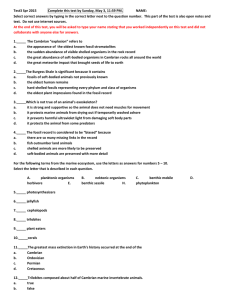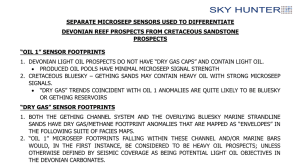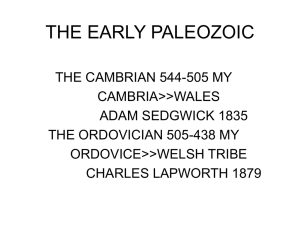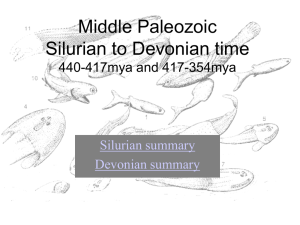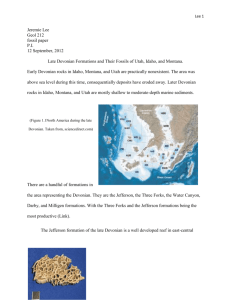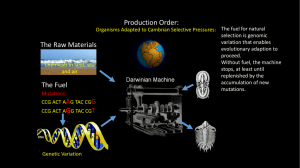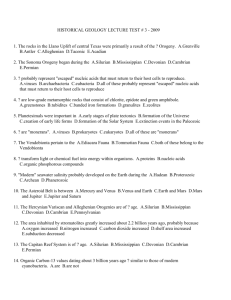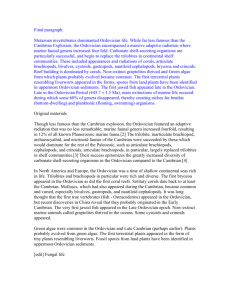Sci Oly- Fossil List
advertisement
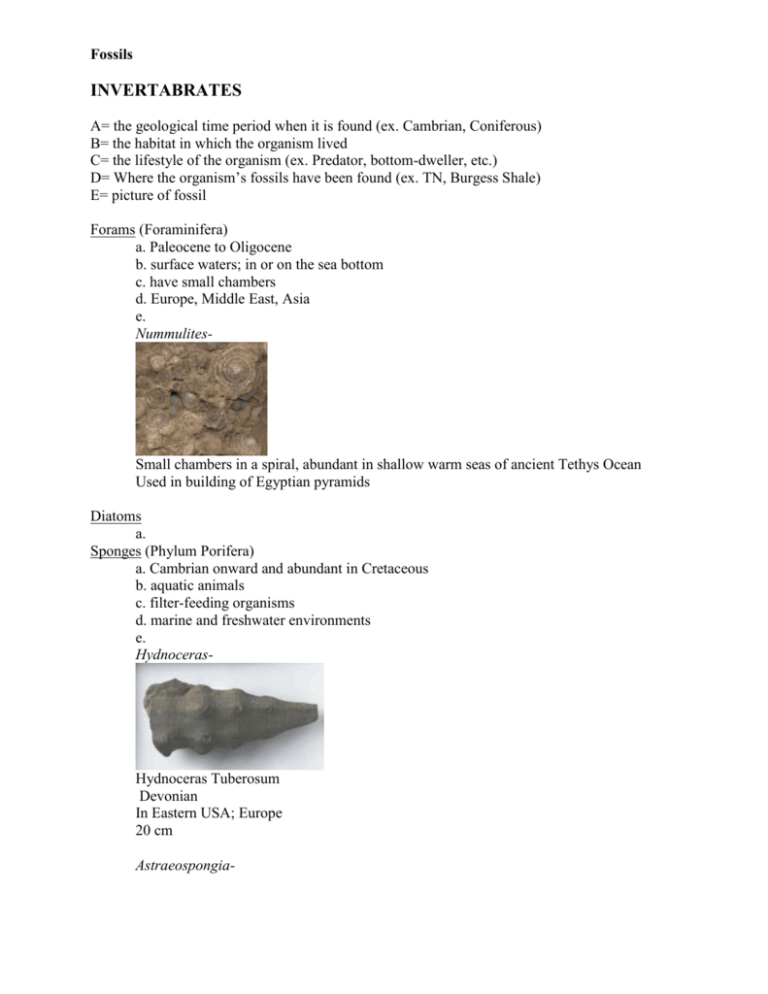
Fossils INVERTABRATES A= the geological time period when it is found (ex. Cambrian, Coniferous) B= the habitat in which the organism lived C= the lifestyle of the organism (ex. Predator, bottom-dweller, etc.) D= Where the organism’s fossils have been found (ex. TN, Burgess Shale) E= picture of fossil Forams (Foraminifera) a. Paleocene to Oligocene b. surface waters; in or on the sea bottom c. have small chambers d. Europe, Middle East, Asia e. Nummulites- Small chambers in a spiral, abundant in shallow warm seas of ancient Tethys Ocean Used in building of Egyptian pyramids Diatoms a. Sponges (Phylum Porifera) a. Cambrian onward and abundant in Cretaceous b. aquatic animals c. filter-feeding organisms d. marine and freshwater environments e. Hydnoceras- Hydnoceras Tuberosum Devonian In Eastern USA; Europe 20 cm Astraeospongia- Astraeospongia meniscus Silurian Niagara Formation Decatur County, Tennessee 6 cm diameter Note spicules in red circle Astraeospongia meniscus Silurian Beech River Formation Perry County, Tennessee 5.5 cm diameter Astraeospongia meniscus Silurian Beech River Formation Perry County, Tennessee 5.5 cm diameter Side View Bryozoans a. Ordovician to recent b. reef systems, colonies prefer clear water c. grow as encrustations on shells and other objects, form branching structures, thin lacey forms, or stony growths d. Mississippi? e. Archimedes- Bryozoan Archimedes Central Corkscrew Support Lacy Zoarium Branches Missing Carboniferous Mississippi, USA Rhombopora- (?) Bryozoan Batostoma jamesi Waynesville Formation Ordovician St. Leon, IN Graptolites (Phylum Hemichordata) a. Corals (Phylum Cnidaria) a. Arthropods a. Silurian period? b. many adaptations- deepest oceans to highest mountains, coldest ice to hottest deserts c. d. Baltic amber, Burgess Shale Trilobites a. Cambrian b. ocean c. juveniles- swimming in plankton, adults- benthic detritus feeders (bottom feeders) except agnostids- pelagic life (open sea at bottom) d. e. Phacops- Trilobite Phacops megalomanicus Devonian Atlas Mountains, Morocco 9.5 cm long x 5.5 cm wide Trilobite Conocoryphe sulzeri Middle Cambrian Jince, Czech Republic Larger Tilobite 3 cm Phacops- had schizochroal eyes which made up of larger spherical-shaped lenses numbering in the hundreds (up to 700) and separated by exoskeleton. Each lens is made of two calcite crystals arranged as a doublet lens (lens used together). IsotelusCryptolithus- species that lost eyes Trilobite Molt Cryptolithus tessellatus Kope Formation Ordovician Ft. Mitchell, KY Elrathia- Elrathia kingii House Range and Drum Mountains Western Utah, USA Wheeler Shale Formation Cambrian: 505 Million Years Eurypterids a. Ordovician to the Permian b. marine c. predator until Silurian d. New York’s state fossil e. Eurypterus remipes Fiddler Green Formation Phelps Member Upper Silurian Herkimer Co., New York Specimen is 9 cm long Insects a. wingless insects- Devonian, winged insects- Pennsylvanian, Herbivorous insectsCarboniferous, Insects w/ complete metamorphosis- Permian, Social insects- Cretaceous, FleasTertiary b. c. parasite, herbivore d. e. Baltic Amber with Inclusion Wasp (Order Hymenoptera) Cenozoic; Paleocene; Eocene Yantarny, Kaliningrad, Russia 4.5 cm long x 3 cm wide x 1.5 cm thick Carbonized Insects Green River Formation Cenozoic; Paleocene; Eocene Kemmerer, Wyoming Slab 6 cm x 4 cm Crustaceans (shrimp, lobster, crabs, barnacles) a. Cambrian to recent, familiar Decapods- Devonian, crabs-Jurassic b. marine environments-most successful, few freshwater and terrestrial c. ate mollusks and brachiopods, predator d. e. Shrimp Cretaceous Haquel, Lebanon Brachiopods (Rhynchonella in Kit) a. Cambrian to recent Inarticulate a. Cambrian b. c. d. e. Lingula Articulate a. Ordovician b. deep water and shallow environments. Majority- shallow water and intertidal zones c. filter feeders d. state fossil for Kentucky e. PlatystrophiaAtrypa- Atrypa Pedicle Valve Devonian Iowa 1.9 cm wide x 1.7 cm tall Atrypa Brachial Valve Devonian Iowa 1.9 cm wide x 1.7 cm tall Mucrospirifer- Mucrospirifer Brachial Valve Devonian New York 3.5 cm wide x 1.8 cm tall Mucrospirifer Pedicle Valve Devonian New York 3.5 cm wide x 1.8 cm tall Rafinesquina- Brachiopod Rafinesquina ponderosa Waynesville Formation Ordovician St. Leon, IN Note: This Rafinesquina, an articulate brachiopod, is covered with inarticulate brachiopods LeptaenaComposita- Composita Pennsylvanian Missouri 1.8 cm long x 1.3 cm wide Composita Pennsylvanian Missouri 1.8 cm long x 1.3 cm wide Side View Showing Aladdin Oil Lamp Shape JuresaniaMollusks (Phylum Mollusca) a. Cambrian b. marine environment most common, freshwater streams, lakes, springs, and marshes c. predators Bivalves (clams, mussels, oysters) a. Mesozoic c. feed by filtering particles from the water through siphons. Possess a foot, but have limited mobility. d. burrow in sediment, stone, or wood. Classified by their hinges e. Pecten- (scallop) Gryphaea- Gryphaea arcuata "Devil's Toenail" Left valve (right valve on bottom) Jurassic England 6 cm long Exogyra- (oyster) Exogyra ponderosa Left Valve Cretaceous Texas 14 cm long Pholadomya- Pholadomya ambigua Early Jurassic; UK. 4 cm Gastropods (snails) a. Cambrian to recent b. marine, freshwater, land e. Conus- (cone shell) Conus (Lithoconus) Sauridens Middle Eocene, USA 6 cm Turritella- Turritella Miocene Santa Monica Mountain, California 3.5 to 4.5 cm Worthenia- Worthenia tabulata Pennsylvanian Wise County, Texas 2.4 cm tall Platyceras- (sea snail) Platyceras sp. Devonian Moscow Formation Little Beards Creek Leicester, New York 2.5 cm long Cypraea- Cephalopods a. b. c. d. o Nautiloids a. Paleozoic e. Orthoceras- a straight horn Nautilis- Nautilus with Siphuncle Cretaceous; Albian Stage Mahajanga, Madagascar o Ammonoids (Ammonites?) a. Devonian to Permian (Mesozoic) e. Dactylioceras- Baculites- Baculite Fox Hills Formation, Cretaceous South Dakota 9.5 cm long o Belemnoids (Belemnites?) a. Mesozoic b. marine rocks c. internal, chambered shell, cylindrical e. Belemnitella- Belemnitella Mucronata (Schlotheim) Late Cretaceous; Holland Belemnite Cylindroteuthis oweni Kelovey Formation, Jurassic Rizan, Russia Echinoderms a. first appearance in Cambrian b. strictly solitary marine organisms Crinoids a. b. massive calcite skeleton c. filter feeders d. abundant in Paleozoic seas e. stems- singe tube connecting to cup columnals- many columns make up one stem calyxes- cup is at the base connected to stem and arms Crinoid Montgomery County, Indiana Edwardsville Formation Paleozoic; Mississippian 12 cm long x 2.5 cm at widest Echinoids c. sea beds e. Sea Urchins- Sea Urchin Echinocorys vulgaris Cretaceous, Campanian Alemannia Quarry, Hoever Hannover Lower Saxony, Germany 7 cm long Sea Urchin Heart Urchin Micraster kunolus Cretaceous Germany 6 cm long Sand Dollars- Fossil Sand Dollars Oligocene Bordeaux, France Specimens are 6.5 cm in diameter Sand Dollar Tertiary Kettleman Hills Coalinga, California 4 cm Stelleroids or look up “Asteroids” (Starfish) a. back into the Ordovician b. in the water e. Sea Stars- Sea Star Ordovician Morocco, Africa 2 cm Brittle Stars- Brittle Star Solnhofen Limestone Late Jurassic Germany 5 cm across Brittle Star Urasterella asperula Lower Devonian Budenbach, Germany Specimen is 3 cm x 3.5 cm Blastoids a. Silurian to the Permian b. attached to hard substrate on sea bed e. Pentremites- Blastoids Montgomery County, Indiana Edwardsville Formation Paleozoic; Mississippian Specimens are 2 cm long x 1.5 cm wide VERTEBRATES Fish Jawless fish (Agnathans) a. Time period - Devonian (from 405 million to 345 million years ago) b. Habitat - oceans (born in rivers, then return to rivers to reproduce) c. Lifestyle - scavengers d. fossils found in - British Columbia e. Pictures: Hagfish- Lampreys- Conodonts- Armored Fish (Placoderms) a. Time Period - Devonian (from 405 million to 345 million years ago) b. Habitat - fresh water c. Lifestyle - predator d. Where the fossils are found - various locations e. Pictures: Genus: Dunkleosteus- Genus: Bothriolepis- Cartilagenous Fish (Chondrichthyans) a. Time period - Early Devonian Period to Today b. Habitat - saltwater c. Lifestyle - predator d. Where the fossils are found - various locations e. Pictures: Shark- Shark Teeth- Ray- Bony Fish (Osteichthyans) a. Time Period - Late Devonian period to today b. Habitat - fresh or saltwater c. Lifestyle - herbivore d. Where fossils are found: various locations e. Pictures: Ray Finned Fish- Lobe Finned Fish- Reptiles Dinosaurs Birds a. Late Jurassic b. Forested areas c. most likely hunted small prey, seizing it with its jaws if it was small enough or with its claws if it was larger d. only specimens of Archaeopteryx that have been discovered come from the Solnhofen limestone in Bavaria, southern Germany, which is a lagerstätte, a rare and remarkable geological formation known for its superbly detailed fossils. e. Genus - Archaeopteryx Mammals Genus – Basilosaurusa. Late Eocene b. Shallow warm seas around the world; surface-dweller c. Predator d. Louisiana, USA; Egypt; Pakistan e. Genus – Mammuthus- (Mammoth) a. Early Pliocene to Middle Holocene b. tundra-like steppe environment, grassland c. grazing herbivore d. Alaska and Washington, USA e. Genus – Mammut- (Mastodon) a. Oligocene through Pleistocene b. Grassy plains c. grazing herbivore d. Democratic Republic of the Congo, Bolivia, England, Germany, the Netherlands, North America, Romania, and northern Greece. e. Genus – Hyracotheriuma. Early Eocene–Mid Eocene b. woodlands of the northern hemisphere c. grazing herbivore d. Wyoming, USA e. Genus – Equusa. Early Pleistocene to recent b. grassy plains c. grazing herbivore d. Idaho, USA; southern Texas e. Genus – Smilodona. Late Pliocene to Late Pleistocene b. grasslands, shrubby areas, and pine forests c. Predator d. La Brea Tar Pits in California, USA e. Genus sp. – Homo neanderthalensisa. Pleistocene b. Cold northern climate c. Omnivore hunter-gatherers d. Portugal, Ukraine, Gibraltar, France, Spain, Britain Germany, Czech Republic, Slovakia, Croatia, Greece, Iraq, Israel, Iran, Romania and Russia. e.
